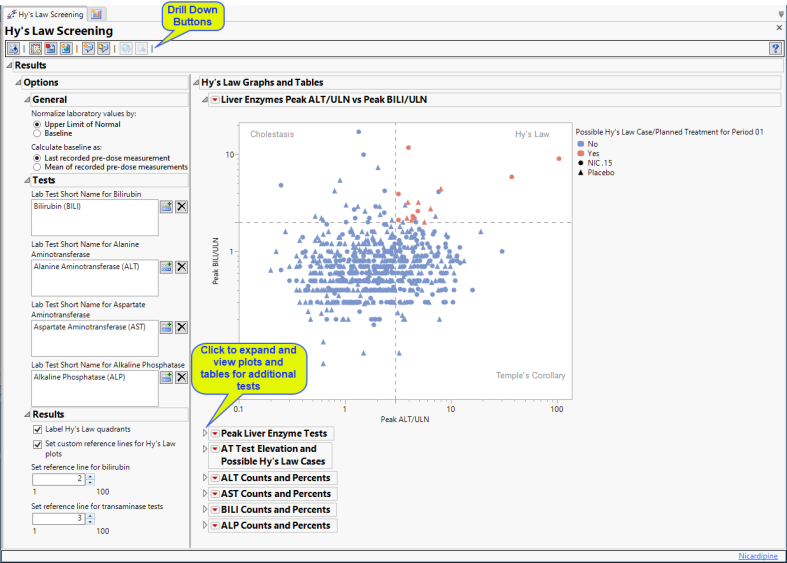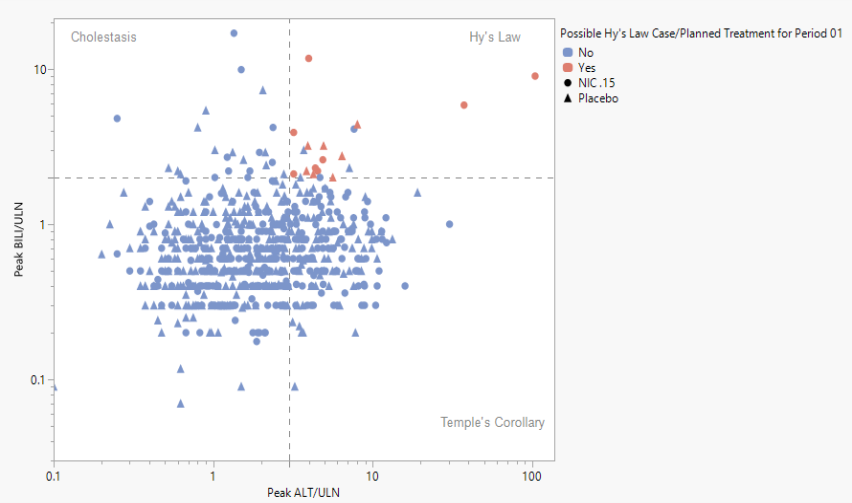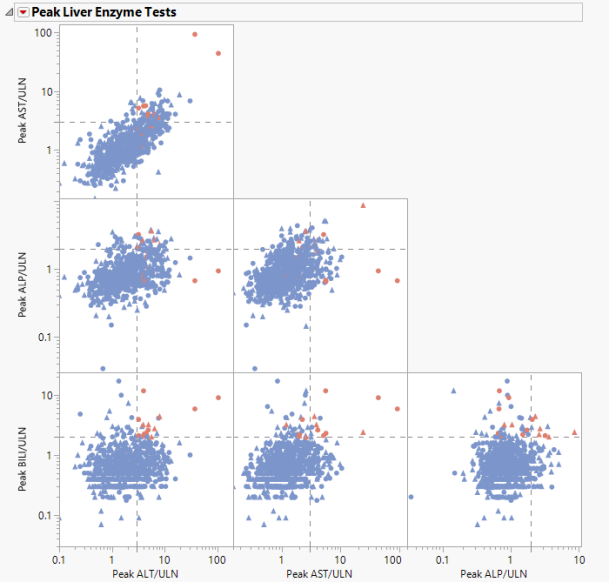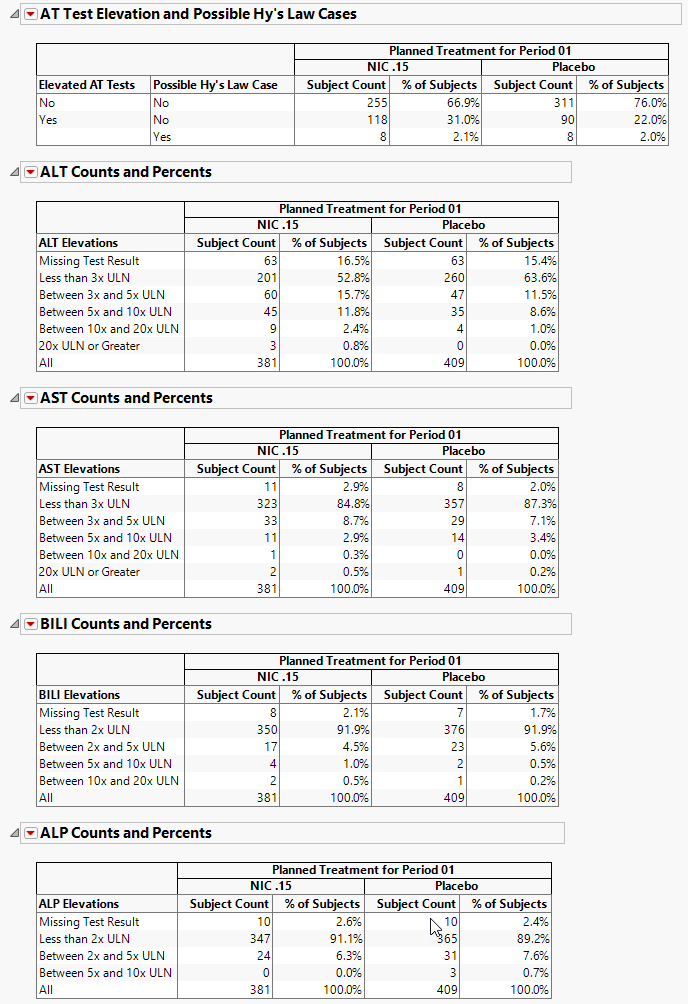Hy’s Law Screening
This report visualizes peak values for lab measurements pertaining to Hy's Law for detecting potential liver toxicity for all subjects across treatment arms. Lab measurements for Bilirubin (BILI), Alanine Aminotransferase (ALT), Aspartate Aminotransferase (AST), and Alkaline Phosphatase (ALP) are divided by the upper limit of normal (ULN) and displayed in a scatterplot matrix annotated with Hy's Law reference lines (2*ULN of BILI, 3*ULN of ALT).
This analysis also creates reports of the distributions of relevant liver test variables, tables of missing tests and categorized liver elevation levels, and displays of the peak liver test values by Study day.
Note: This analysis can still be run on a blinded study but certain components of the reports are suppressed.
Note: JMP Clinical uses a special protocol for data including non-unique Findings test names. Refer to How does JMP Clinical handle non-unique Findings test names? for more information.
Report Results Description
Running this report with the Nicardipine sample setting generates the report shown below.

The Report contains the following elements:
Hy’s Law Screening
Displays an overall scatterplot of peak ALT, AST , BILI, and ALP measurements across the study, with color used to flag subjects meeting Hy's Law criteria.

The Hy’s Law Screening section consists of the following elements:
| • | One Overlay Plot of Hy's Law Lab Tests. |
This plot shows maximum laboratory values for the Alanine Aminotransferase ( ALT), Aspartate Aminotransferase ( AST ), Total Bilirubin (BILI), and Alkaline Phosphatase (ALP) laboratory tests. The values are log2 transformed (this can be changed to log10 or no transformation in the report dialog) and normalized by the Upper Limit of Normal (LBSTNRHI). Reference lines are drawn by default at 3*ULN for ALT and AST and 2*ULN for BILI and ALP. These reference limits can be customized on the dialog.
These limits are also used to create the Hy's Law indicator flag. Subjects with a test value exceeding 3*ULN for ALT or AST (signs of hepatocellular injury) accompanied or followed by elevation of 2*ULN or greater for the BILI test have a "Yes" value for the Hy's Law Case variable created. A note defining the Hy's Law flag is located above the scatterplot matrix. For example, with the default settings the note is as follows: "Hys Law Cases are flagged if ALT or AST >= 3*ULN and BILI >= 2*ULN within 0 Days of ALT/AST peak." You can change the number of days following ALT/AST elevation for which to look for BILI elevation to flag possible Hy's Law cases on the report dialog. Subjects in the plot are colored by the Hy's Law criteria (red for "Yes", blue for "No") and marked by their treatment arm. You can choose to label the quadrants of Hy's Law (Cholestasis, Hy's Law, and Temple's Corollary) in the bottom left scatterplot through a check box option on the dialog.
Scatterplots
Displays scatterplots of peak ALT, AST, BILI, and ALP measurements across the study, with color used to flag subjects meeting Hy's Law criteria. Two contingency analyses show duration of Hy's Law and incidence of ALT or AST elevation by treatment.

The Scatterplots section contains the following elements:
| • | One Scatterplot Matrix of Hy's Law Lab Tests. |
Tip: Adjust the size of the scatterplot matrix using the Frame Size slider, located at the upper left corner of the tab.
This plot shows maximum laboratory values for the Alanine Aminotransferase ( ALT), Aspartate Aminotransferase (AST ), Total Bilirubin (BILI), and Alkaline Phosphatase (ALP) laboratory tests. The values are log2 transformed (this can be changed to log10 or no transformation in the report dialog) and normalized by the Upper Limit of Normal (LBSTNRHI). Reference lines are drawn by default at 3*ULN for ALT and AST and 2*ULN for BILI and ALP. These reference limits can be customized on the dialog.
These limits are also used to create the Hy's Law indicator flag. Subjects with a test value exceeding 3*ULN for ALT or AST (signs of hepatocellular injury) accompanied or followed by elevation of 2*ULN or greater for the BILI test will have a "Yes" value for the Hy's Law Case variable created. A note defining the Hy's Law flag is located above the scatterplot matrix. For example, with the default settings the note is as follows: "Hys Law Cases are flagged if ALT or AST >= 3*ULN and BILI >= 2*ULN within 0 Days of ALT/AST peak." You can change the number of days following ALT/AST elevation for which to look for BILI elevation to flag possible Hy's Law cases on the report dialog. Subjects in the plot are colored by the Hy's Law criteria (red for "Yes", blue for "No") and marked by their treatment arm. You can choose to label the quadrants of Hy's Law (Cholestasis, Hy's Law, and Temple's Corollary) in the bottom left scatterplot through a check box option on the dialog.
Tables
Contains tables corresponding to AT Test Elevation and Potential HY's Law Cases, as well as counts and percentages for elevation categories for each liver test.

It contains the following elements:
| • | One AT Test Elevation and Potential Hy’s Law Cases table. |
Note: This table is shown only if at least one subject has a value of “Yes” for Elevated AT Tests.
This table lists subject count and percentages by treatment variable for subjects experiencing ALT or AST Elevation, or those defined as a Hy's Law Case, or both.
| • | A table of Counts and Percents for elevation categories for each liver test. |
You can select cells of these tables (either counts or percents) to select the corresponding rows in the data table.
Results for the various tests are sorted into rows as described in the following tables:
| For ALT and AST | |
|---|---|
|
Row |
Contains subjects who show results that are: |
|
Missing Test Result |
See below. |
|
Less than 3x ULN |
less than 3x the upper limit of normal (ULN) |
|
Between 3x and 5x ULN |
inclusive of greater than or equal to 3x ULN and less than 5x ULN |
|
Between 5x and 10x ULN |
inclusive of greater than or equal to 5x ULN and less than 10x ULN |
|
Between 10x and 20x ULN |
inclusive of greater than or equal to 10x ULN and less than 20x ULN |
| For BILI and ALP | |
|---|---|
|
Row |
Contains subjects who show results that are: |
|
Missing Test Result |
See below. |
|
Less than 2x ULN |
less than 2x the upper limit of normal (ULN) |
|
Between 2x and 5x ULN |
inclusive of greater than or equal to 2x ULN and less than 5x ULN |
|
Between 5x and 10x ULN |
inclusive of greater than or equal to 5x ULN and less than 10x ULN |
|
Between 10x and 20x ULN |
inclusive of greater than or equal to 10x ULN and less than 20x ULN |
Note: Thresholds for ALT/AST and BILI/ALP are set based on guidelines from USDHHS, FDA and CDER (https://www.fda.gov/media/71665/download).
Missing Test Result is calculated as count (and percent) of subjects who had no record of a specific test (there is no row in the lb data set for the respective LBTEST for the subject) at any day of the study, have no nonmissing measurement(s) for the recorded test (LBSTRESN is a missing value), or are missing the upper limit of normal reference limit (LBSTNRHI is a missing value).
Important: The counts and percentages for Missing Test Result on this section are calculated out of all subjects that have at least one nonmissing result for at least one of the liver lab tests. The counts shown on the Hy’s Law Screening section include subjects that had no record or were missing all values for all four liver lab tests.
Note: These tables are derived from the same data table that the Hy’s Law Screening, Scatterplots, and Hy’s Law Screening sections are derived from, so any selections that you make are reflected across those tabs.
You can run downs off of table cell selections for an additional level of dynamic exploration.
Options

General
Normalize Lab Measurements by:
You can choose to normalize the measurements by either the ULN or the baseline measurements for each test. See Use the Normalize laboratory values by: for more information.
Selecting ULN normalizes the data to the upper limit of the expected normal range and is best used when you expect the values to exceed the normal range. Normalized values greater than one are considered to be higher than normal.
Selecting Baseline performs the screening with laboratories normalized in reference to baseline measurements (normalization determined by measurements flagged as baseline, measurements taken prior to Study Day 1, or both).
Calculate baseline as:
Use the Calculate baseline as: widget to use the last recorded pre-dose measurement or the mean of all the measurements taken during the baseline time window as the baseline measurement.
Tests
This report requires lab results for bilirubin, alanine aminotransferase, aspartate aminotransferase, and alkaline phosphatase. At least one of the standardized short name character strings listed in the following table must be present in the LBTESTCD column for each lab result.
|
Lab Test1: |
Required String: |
|
Bilirubin |
Either BILI or TBIL Note: If neitherBILInorTBILare found, the report searches for and usesTBILI,TBL,BILT,BILTOT,andBIL(in that order). |
|
Alanine Aminotransferase |
Either ALT, ALAT, or SGPT |
|
Aspartate Aminotransferase |
Either AST, ASAT, or SGOT |
|
Alkaline Phosphatase |
Either ALP or ALKP Note: If neither ALP nor ALKP are found, the report searches for and uses ALK and APH, in that order. |
Use the text fields in these widgets to specify the Test Short Name (LBTESTCD ) value that corresponds to each of the tests associated with Hy’s Law screening. These include tests for bilirubin, alanine aminotransferase, aspartate aminotransferase, and alkaline phosphatase. These widgets enable you to specify individual tests when non-standard test names are used in the study. If these options are left blank, JMP Clinical uses the standard test designations.
See Lab Test Short Name for Bilirubin, Lab Test Short Name for Alanine Aminotransferase, Lab Test Short Name for Aspartate Aminotransferase, and Lab Test Short Name for Alkaline Phosphatase for more information.
Results
These widgets enable you to adjust the report according to the needs of your organization.
Label Hy's Law quadrants
Selecting Label Hy’s Law quadrants places identifying labels, relating to Hy’s law, in each quadrant of all of the plots of bilirubin versus alanine aminotransferase.
Set custom reference lines for Hy's Law plots
Use the Set custom reference lines for Hy’s Law plots widget to draw reference lines on the Hy’ Law plots.
Set reference lines for bilirubin
When you check the Set custom reference lines for Hy's Law plots check box, you must also use the Set reference line for bilirubin widget to specify the value by which to multiply the ULN for bilirubin and/or alkaline phosphatase. By default, this value is set to 2 or twice the ULN.
Set reference lines for transaminase tests
When you check the Set custom reference lines for Hy's Law plots check box, you must also use the Set reference line for transaminase tests widget to specify the value by which to multiply the ULN for alanine and/or aspartate transaminase. By default. this value is set to 3 or 3x the ULN.
General and Drill Down Buttons
Action buttons, provide you with an easy way to drill down into your data. The following action buttons are generated by this report:
| • | Click  to rerun the report using default settings. to rerun the report using default settings. |
| • | Click  to view the associated data tables. Refer to Show Tables/View Data for more information. to view the associated data tables. Refer to Show Tables/View Data for more information. |
| • | Click  to generate a standardized pdf- or rtf-formatted report containing the plots and charts of selected sections. to generate a standardized pdf- or rtf-formatted report containing the plots and charts of selected sections. |
| • | Click  to generate a JMP Live report. Refer to Create Live Report for more information. to generate a JMP Live report. Refer to Create Live Report for more information. |
| • | Click  to take notes, and store them in a central location. Refer to Add Notes for more information. to take notes, and store them in a central location. Refer to Add Notes for more information. |
| • | Click  to read user-generated notes. Refer to View Notes for more information. to read user-generated notes. Refer to View Notes for more information. |
| • | Click  to open and view the Subject Explorer/Review Subject Filter. to open and view the Subject Explorer/Review Subject Filter. |
| • | Click  to specify Derived Population Flags that enable you to divided the subject population into two distinct groups based on whether they meet very specific criteria. to specify Derived Population Flags that enable you to divided the subject population into two distinct groups based on whether they meet very specific criteria. |
Default Settings
Refer to Set Study Preferences for default Subject Level settings.
Methodology
No testing is performed. Analysis is restricted to calculating simple statistics of findings results or their normalized values.